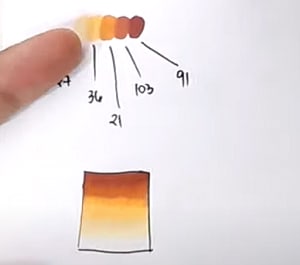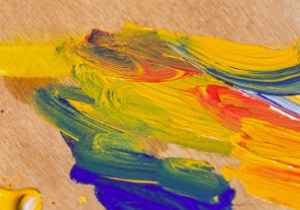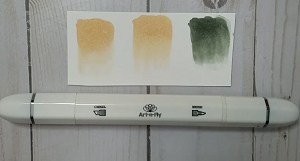When your permanent marker color palette and blending techniques seem so mundane, you can revamp your artwork using a colorless blender marker. You can get the most out of these blending pens when used correctly – from seamless color blends and new hues to exquisite artistic effects.
The next step is to know how to use a colorless blender marker. Fortunately, you can use it like a pro with just a few easy steps.
Table of Contents
Simple Ways to Use a Colorless Blender Marker
What to Prepare
- Colorless blender marker
- Sketchbook or drawing book for permanent markers (bleed proof)
- Scrap paper
- A piece of plastic (as a mixing palette)
Method 1: Tip-to-Tip Blending to Produce Lighter Colors
This method picks up the color from the tip of the permanent marker and transfers the ink to the paper. It is one of the best ways to create a lighter version of the color and blend the tones seamlessly.
- Place the tip of the permanent marker over the colorless blender marker tip. Take note of the positions when you use blending markers to ensure quick and effective color transfers.
- Hold the tips for a few seconds until the colorless blender marker picks up enough ink.
- The colorless blender now has diluted ink to fill in a space with a lighter color. Move the blender in a uniform direction (upward or downward) to produce smooth color transitions.
- Repeat the steps if you need to add more color.
Method 2: Make Brand New Colors
When you are missing a specific color and want to customize your palette, a colorless blender marker can work as a paintbrush to mix different colors.
- Take a piece of plastic and use it as a mixing palette. It is best to use plastic to mix the colors smoothly and pick them up easily.
- Choose colored permanent markers that you want to mix. Make color swatches on the piece of plastic.
- Use the colorless blender marker like a paintbrush. If you use Ohuhu colorless blender marker pens, use the chisel tip. Then, mix the colors to form a new shade.
- Fill in the space using the blender. The inks from a blender marker transfer new colors on the paper.
Method 3: Blending Light and Dark Colors
A blender marker can bridge the gap between two closer shades of colors. It also does the trick even when you need to make a huge jump in light and dark colors.
- Prime the surface with a colorless blender.
- Apply the lighter shade first. Then, add the darker color, overlapping the lighter shade. Since you are blending with alcohol markers, it is crucial to work while the ink is still wet.
- Add another layer of the colorless blender marker on top of the colors to soften the transition of the tones.
- If you use Copic colorless blender pens, add the darker color first, followed by the colorless blender marker on top to create a fading effect. Then, apply the lighter color over the colorless marker.
Method 4: Make Unique Patterns and Effects
Various blender marker 3D effects, patterns, and textures can be achieved using the chisel and brush nibs of a colorless blender marker.
01 HighlightsUse the chisel tip to create highlights on your color, emphasizing the light source or reflection of an image. Apply the blender marker over the color and move it in a circular motion, upward, or downward.
You may cover the whole surface to lighten the tone or a certain spot to accentuate the light source.
02 Watercolor EffectSimply add a base layer using the colorless blender marker and draw over it. You will notice that the ink spreads out or smears a little, mimicking a watercolor effect.
03 Dots and LinesWhen you use Azure markers or any colorless blender pens, use the brush nib and press the tip down the colored space for a couple of seconds to create dotted shapes. Lay down the brush nib for lines or longer strokes.
04 Squares and Rectangular ShapesUse chiseled nibs such as the Prismacolor markers blender pens and press the tip down the color. Hold it for a few seconds until it creates squares, rectangular shapes, or any angled shapes you want.
Method 5: Create Softer Edges and Tones
The technique is to make a base layer using the colorless blender pen and add a darker color on top. This method helps minimize over-saturation and bleed-throughs due to heavy pressure.
- Prime the surface with a colorless blender marker to create a base layer.
- Add a darker color on top or wherever you want the darker shade to be. Whether you go downward or upward, use flicking motions for controlled pressure and smoother color transitions.
- At this point, the lighter shade blends out seamlessly, leaving softer edges and nice fading effects.
- Add another layer of colorless blender at the bottom of the dark color (or on the lightest area) to lighten the shade even more.
Method 6: Rectify Mistakes and Make Quick Retouches
You can use the colorless blender to rectify ink smears and errors. Although it may not remove mistakes entirely, the blender can conceal them to keep your colors neat and on point.
- Make sure that the tip of the blender is clean. Never use it if there is any marker ink lingering on the tip to avoid color transfers.
- Use the colorless blender and gently press it against the areas that you want to conceal. Depending on the size of the smears or errors, use the brush nib to retouch smaller areas and the chisel nib for the larger areas.
- Scribble the blender tip against scrap paper to clean it. Repeat the procedure if you need to retouch and correct areas with different shades.
Other Helpful Tips & FAQs When Using a Colorless Blender Marker
- Always ensure clean colorless blender marker pens before using them. If there are any ink residues, simply scribble or write against scrap paper until the pigments come off. Do it in an upward, downward, or any single motion to prevent the tip from fraying.
- Colorless blender markers, such as Prismacolor colorless blender marker pens, usually have dual nibs – chisel and brush. You may choose between these nib styles to cover large and small areas efficiently.
Moreover, some blender markers like Chartpak colorless blender marker pens are tri-nib, which you can use to cover small and large areas as well as intricate details.
Related: A comprehensive guide on cleaning Prismacolor colorless blender marker.
What is a Colorless Blender Marker?
It is an alcohol-based clear or colorless marker innovatively designed to produce various techniques with permanent markers.
What Does a Colorless Blender Pen Do?
These colorless alcohol blending markers can blend different colors seamlessly, create watercolor and fading effects, lighten tones, soften edges, conceal marker mishaps, and make unique patterns, highlights, and textures.
Conclusion
Learning the best and easy ways on how to use a colorless blender marker is one way to ramp up your creativity. The tips and methods mentioned in this article are some of the ways to try to revamp your artwork and practice your skills. Just make sure to clean your colorless blender markers every after use and you are good to go!

Art has always been a part of my life; it influences my upbringing and later my career choice. For me, it is always a part of my parenting technique. So for whichever purpose that you come to art, you can start here with us.





